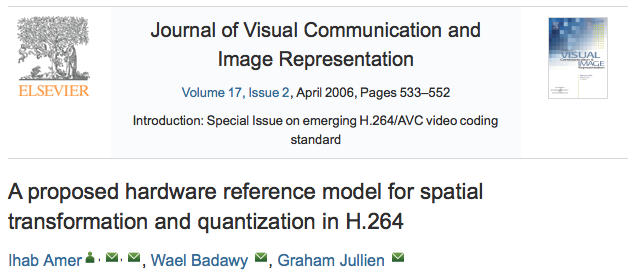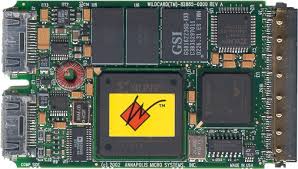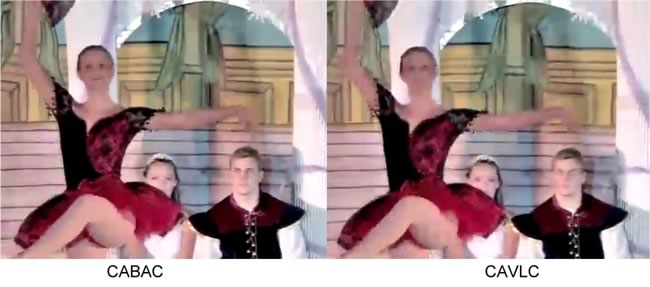Tag: hardware

A new time distributed DCT architecture for MPEG-4 hardware reference model
This paper presents the design of a new time distributed architecture (TDA) which outlines the architecture (ISO/IEC JTC1/SC29/WG11 MPEG2002/M8565) submitted to MPEG4 Part9 committee and included in the ISO/IEC JTC1/SC29/WG11 MPEG2002/9115N document. The proposed TDA optimizes the two-dimensional discrete cosine transform (2-D-DCT) architecture performance. It uses a time distribution mechanism to exploit the computational redundancy within the inner product computation module. The application specific requirements of input, output and coefficients word length are met by scheduling the input data. The coefficient matrix uses linear mappings to assign necessary computation to processor elements in both space and time domains. The performance analysis shows performance savings in excess of 96% as compared to the direct implementation and more than 71% as compared to other optimized application specific architectures for DCT.
Published in:
Circuits and Systems for Video Technology, IEEE Transactions on (Volume:15 , Issue: 5 )
- Page(s):
- 726 – 730
- ISSN :
- 1051-8215
- INSPEC Accession Number:
- 8422879
- DOI:
- 10.1109/TCSVT.2005.846429
- Date of Publication :
- May 2005
- Date of Current Version :
- 02 May 2005
- Issue Date :
- May 2005
- Sponsored by :
- IEEE Circuits and Systems Society
- Publisher:
- IEEE
Alam, M.; Badawy, W.; Jullien, G.; “A new time distributed DCT architecture for MPEG-4 hardware reference model,” IEEE Circuits and Systems for Video Technology, Volume 15, Issue 5, May 2005, pp. 726 – 730.

A Proposed Hardware Reference Model for Spatial Transformation and Quantization in H.264,
This paper presents three Very Large Scale Integration prototypes to exploit spatial redundancy in the H.264 standard. The proposed architectures are: (1) forward 4 × 4 integer approximation of DCT transform and quantization, which is applied to all blocks of a frame, (2) the 4 × 4 Hadamard transform and quantization that is applied to the DC coefficients of the luma component when the macroblock is encoded in 16 × 16 intra prediction mode, and (3) the 2 × 2 Hadamard transform and quantization that is applied to the DC coefficients of the chroma component as a second level in the transformation hierarchy. The developed algorithms are adopted by the H.264 standard. A performance analysis shows that the architectures satisfy the real-time constraints required by different digital video applications.
I. Amer, W. Badawy, G. Jullien, “A Proposed Hardware Reference Model for Spatial Transformation and Quantization in H.264,” Elsevier Journal of Visual Communication and Image Representation, Volume 17, Issue 2, April 2006, Pages 533-552.

A Simplified 8×8 Transformation And Quantization Real-Time Ip-Block For Mpeg-4 H.264/Avc Applications: A New Design Flow Approach
Abstract
Current multimedia design processes suffer from the excessively large time spent on testing new IP-blocks with references based on large video encoders specifications (usually several thousands lines of code). The appropriate testing of a single IP-block may require the conversion of the overall encoder from software to hardware, which is difficult to complete in the short time required by the competition-driven reduced time-to-market demanded for the adoption of a new video coding standard. This paper presents a new design flow to accelerate the conformance testing of an IP-block using the H.264/AVC software reference model. An example block of the simplified 8 × 8 transformation and quantization, which is adopted in FRExt, is provided as a case study demonstrating the effectiveness of the approach.
Ihab Amer, Wael Badawy, Graham Jullien, Marco Mattavelli, And Robert Turney, “A Simplified 8×8 Transformation And Quantization Real-Time Ip-Block For Mpeg-4 H.264/Avc Applications: A New Design Flow Approach,” Journal of Circuits, Systems, and Computers Vol. 16, No. 6 (2007) 1011–1026
Link to the list of other Peer Journal Publications

